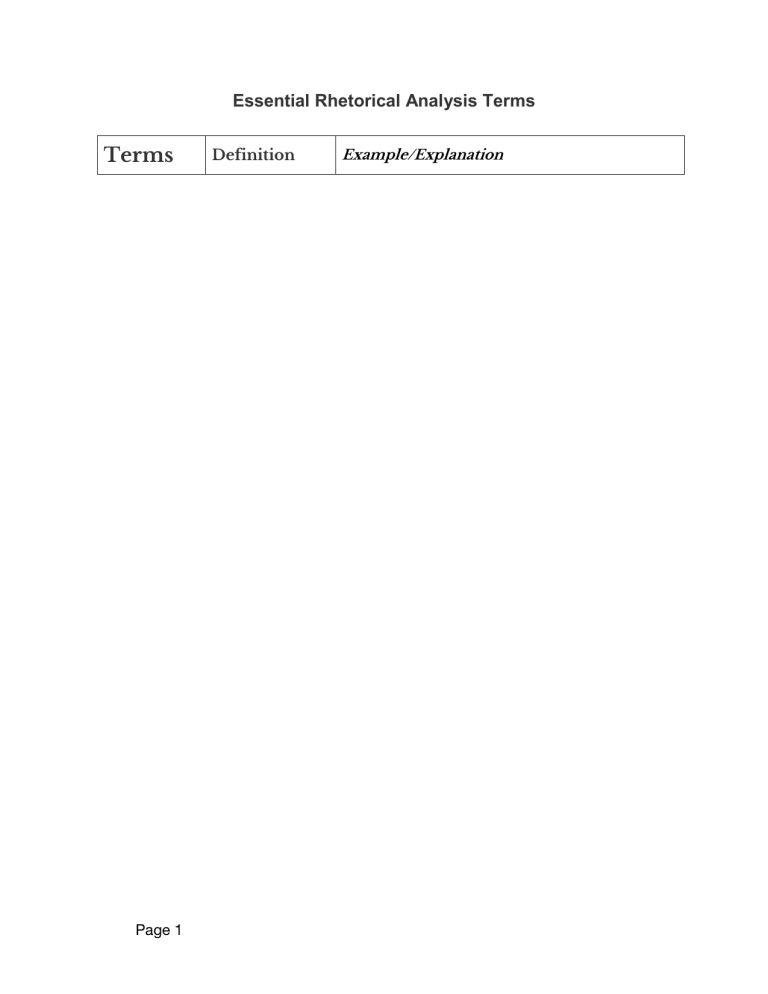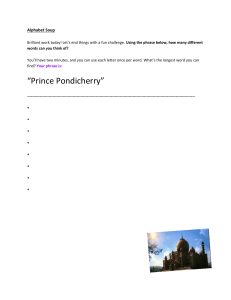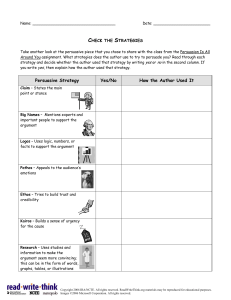
Essential Rhetorical Analysis Terms Terms Page 1 Definition Example/Explanation Analogy Explaining something complex by comparing it to something more simple. Argument The combination of reasons, evidence, etc that an author uses to convince an audience of their position. Aristotelian appeals Three different methods of appealing to an audience to convince them—ethos, logos, and pathos. Attitude The writer's personal views or feelings about the subject at hand. Audience Who the author is directing his or her message towards Page 2 Compare and contrast Discussing the similarities and differences between two things to some persuasive or illustrative purpose. Connotatio n The implied meaning of a word; words can broadly have positive, negative, or neutral connotations. Context The extratextual environment in which the text is being delivered. Counterarg ument The argument(s) against the author's position. Deductive reasoning A form of logical reasoning wherein a general principle is applied to a specific case. Page 3 Denotation The literal, dictionarydefinition meaning of a word. Diction The style of language used; generally tailored to be appropriate to the audience and situation. Ethos Setting up a source as credible and trustworthy. Evidence The information presented is meant to persuade the audience of the author's position. Figurative language The use of language in a non-literal way; i.e. metaphor, simile, etc. Genre The specific type of work being presented. Page 4 Imagery Any descriptive language used to evoke a vivid sense or image of something; includes figurative language. When something is suggested Implication without being concretely stated. Inductive reasoning Making a generalization based on specific evidence at hand. Irony At the most basic sense, saying the opposite of what you mean; also used to describe situations in which the results of an action are dramatically different than intended. Page 5 Placing two Juxtapositio very different n things together for effect. Logos Appealing to someone's sense of concrete facts and logic. Occasion The reason or moment for writing or speaking. How the different parts of an Organizatio argument are n arranged in a piece of writing or speech. Pathos An Aristotelian appeal. Involves appealing to someone's emotions. Purpose The author's persuasive intention. Repetition Re-using a word or phrase repeatedly for effect or emphasis. Page 6 Rhetoric The use of a spoken or written word (or a visual medium) to convey your ideas and convince an audience. Rhetorical triangle The relationship between the author, the audience, the text/message, and the context. Speaker The persona adopted by the author to deliver his or her message; may or may not actually be the same person as the author. Style The author's own personal approach to rhetoric in the piece; similar to voice. Symbolism Using a symbol to refer to an idea or concept. Page 7 Syntax The way sentences are grammatically constructed. Synthesis Combining sources or ideas in a coherent way in the purpose of a larger point. Themes Overarching ideas or driving premises of a work. Tone The use of stylistic devices to reveal an author's attitude toward a subject. Voice An author's unique sound. Similar to style. Page 8 Terms Definition Alliteration Using words with the same first letter repeatedly close together in a phrase or sentence. Allusion Making a brief reference to the cultural canon— e.g. the Bible, Shakespeare, classical mythology, etc. Anecdote Offering a brief narrative episode. This device can serve many functions in a text—for example, introducing an issue, serving as evidence, illustrating a point, and so on. Concession Agreeing with the opposing viewpoint on a certain smaller point (but not in the larger argument). Didactic A text with an instructive purpose, often moral. Page 9 Example/Explanation Euphemism Referring to something with a veiled phrase instead of saying it directly Exemplification Providing examples in service of a point. Hyperbole Overstating a situation for humorous or dramatic effect. Idiom A commonly used phrase signifies something very different than its literal meaning. Onomatopoeia Using "soundeffect" words (e.g. "clap," "buzz). Paradox A phrase or assertion that appears to contradict itself (but the contradiction itself may have its own meaning). Parallelism Repeated structural elements in a sentence. Parody Using the form of something to mimic and make fun of it. Page 10 Personification Giving human characteristics to a nonhuman object or idea. Sarcasm Mockingly stating the opposite of what you mean. Easier to convey in the spoken word than via writing. Satire A genre of humorous and mocking criticism to expose the ignorance and/or ills of society. Synecdoche Referring to one part of something as a way to refer to the whole. Understatement Deliberately minimizing something, usually for humorous effect. Page 11


